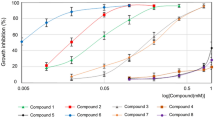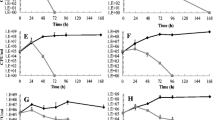Abstract
The addition of sodium azide (a mitochondrial inhibitor) at a concentration of 0.15 mM to glucose-grown Saccharomyces cerevisiae or Candida albicans cells before exposing them to heat shock increased cell survival. At higher concentrations of azide, its protective effect on glucose-grown cells decreased. Furthermore, azide, even at low concentrations, diminished the thermotolerance of galactose-grown yeast cells. It is suggested that azide exerts a protective effect on the thermotolerance of yeast cells when their energy requirements are met by the fermentation of glucose. However, when cells obtain energy through respiratory metabolism, the azide inhibition of mitochondria enhances the damage inflicted on the cells by heat shock.
Similar content being viewed by others
REFERENCES
Wilson, D.F. and Chance, B., Azide Inhibition of Mitochondrial Electron Transport: I. The Aerobic Steady State of Succinate Oxidation, Biochim. Biophys. Acta, 1967, vol. 131, no. 3, pp. 421–430.
Weber, J. and Senior, A.E., Effects of the Inhibitors Azide, Dicyclohexylcarbodiimide, and Aurovertin on Nucleotide Binding to the Three F1-ATPase Catalytic Sites Measured Using Specific Tryptophan Probes, J. Biol. Chem., 1998, vol. 273, no. 50, pp. 33210–33215.
Brown-Peterson, N.J. and Salin, M.L., Purification and Characterization of a Mesohalic Catalase from the Halophilic Bacterium Halobacterium halobium, J. Bacteriol., 1995, vol. 177, no. 2, pp. 378–384.
Takeda, T., Yoshimura, K., Ishikawa, T., and Shigeoka, S., Purification and Characterization of Ascorbate Peroxidase in Chlorella vulgaris, Biochimie, 1998, vol. 80, no. 4, pp. 295–301.
Misra, H.P. and Fridovich, I., Inhibition of Superoxide Dismutases by Azide, Arch. Biochem. Biophys., 1978, vol. 189, no. 2, pp. 317–322.
Rikhvanov, E.G., Varakina, N.N., Rusaleva, T.M., Rachenko, E.I., Kiseleva, V.A., and Voinikov, V.K., The Effect of Sodium Azide on the Thermotolerance of the Yeasts Saccharomyces cerevisiae and Debaryomyces vanriji, Mikrobiologiya, 2001, vol. 70, no. 3, pp. 300–304.
Medentsev, A.G., Arinbasarova, A.Yu., and Akimenko, V.K., The Regulation and Physiological Role of Alternative Oxidase in Fungi and Plants, Biokhimiya, 1999, vol. 64, no. 11, pp. 1457–1472.
Huh, W.-K. and Kang, S.-O., Molecular Cloning and Functional Expression of Alternative Oxidase from Candida albicans, J. Bacteriol., 1999, vol. 181, no. 13, pp. 4098–4102.
Huh, W.-K. and Kang, S.-O., Characterization of the Gene Family Encoding Alternative Oxidase from Candida albicans, Biochem. J., 2001, vol. 356, part 2, pp.595–604.
Rukovodstvo po izucheniyu biologicheskogo okisleniya polyarograficheskim metodom (Manual on the Study of Biological Oxidation by the Polarographic Method), Moscow: Nauka, 1973.
Lagunas, R., Misconceptions about the Energy Metabolism of Saccharomyces cerevisiae, Yeast, 1986, vol. 2, no. 4, pp. 221–228.
Sanchez, Y., Taulien, J., Borkovich, K.A., and Lindquist, S., Hsp104 Is Required for Tolerance to Many Forms of Stress, EMBO J., 1992, vol. 11, no. 6, pp.2357–2364.
Davidson, J.F., Whyte, B., Bissinger, P.H., and Schiestl, R.H., Oxidative Stress Is Involved in Heat-induced Cell Death in Saccharomyces cerevisiae, Proc. Natl. Acad. Sci. USA, 1996, vol. 93, no. 10, pp. 5116–5121.
Kreger van Rij, N.J.W., Debaryomyces Lodder et Kreger van Rij nom. conserv., The Yeast: A Taxonomic Study, Lodder, J., Ed., Amsterdam: North-Holland Publishing, 1970, pp. 129–156.
Veiga, A., Arrabaca, J.D., and Lureiro-Dias, M.C., Cyanide-Resistant Respiration Is Frequent, but Confined to Yeasts Incapable of Aerobic Fermentation, FEMS Microbiol. Lett., 2000, vol. 190, no. 1, pp. 93–97.
van Uden, N. and Buckley, H., Candida Berkhout, The Yeast: A Taxonomic Study, Lodder, J., Ed., Amsterdam: North-Holland Publishing, 1970, pp. 893–1087.
Author information
Authors and Affiliations
Rights and permissions
About this article
Cite this article
Rikhvanov, E.G., Varakina, N.N., Rusaleva, T.M. et al. The Effect of Sodium Azide on the Thermotolerance of the Yeasts Saccharomyces cerevisiae and Candida albicans. Microbiology 71, 662–665 (2002). https://doi.org/10.1023/A:1021423705253
Issue Date:
DOI: https://doi.org/10.1023/A:1021423705253




